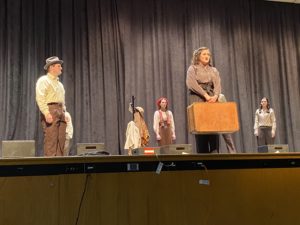
Though International Holocaust Remembrance Day came and went in January, the mission to instill the gravity of the Shoah to the next generation continues for the Jewish Federation of Greater Philadelphia’s Jewish Community Relations Council and Philadelphia’s salon-style Theatre Ariel.
The pair partnered to tour the play “Survivors” across six Philadelphia public and charter middle and high schools from March 28 to April 7 as part of JCRC’s Youth Symposium on the Holocaust.
The play, written by Santa Barbara, California-based playwright Wendy Kout, follows the stories of 10 young Holocaust survivors as they endure the hardships of Nazi rule and concentration camps. The play uses the real stories and names of Holocaust survivors.
“Survivors” was funded by the Foundation for Jewish Day Schools through Pennsylvania’s Educational Improvement Tax Credit Program.
The dwindling number of survivors alive or able to share their stories, combined with the pandemic limiting large, in-person gatherings, forced the JCRC Holocaust Remembrance and Education subcommittee to reconsider the format of the Youth Symposium. The program used to consist of survivors speaking with more than 1,000 students congregated in a large auditorium or conference center.
“Although we cannot bring Holocaust survivors into schools because of COVID and public health concerns, we believe this play is a great alternative, as it retells the stories of actual Holocaust survivors and illustrates the importance of standing up against hatred,” JCRC Director Jason Holtzman said.
“We came up with the idea to use theater as a way to create emotional connection and provide a valuable program that schools would want to bring students to,” Jewish Federation Senior Manager of Community Engagement Beth Razin added.
The play was commissioned in 2018 by Ralph Maranto, artistic director of CenterStage Theatre of the JCC in Rochester, New York, and written by Kout for the same reason.
“Basically, Ralph said, ‘Wendy, I’ve been thinking: How are we going to continue to tell these important stories?’” Kout said. “‘We have websites where students can go online and listen to interviews, and that’s all well and good. But there has to be a more personal way to interact with students than just a screen.’”
The memory of the neo-Nazi march in Charlottesville, Virginia, in August 2017 — defined by the images of white supremacists screaming with torches in their hands — underlined the urgency of the project for Kout.
Kout chose to use real survivors’ stories, but have the characters in the play be the age of the survivor during their time in World War II-era Europe. In addition to providing historical accuracies of the time, Kout wanted to capture the coming-of-age that still took place for the children of the Holocaust.
“We knew we weren’t going to dumb it down, and we weren’t going to make it ‘Holocaust lite,’” Kout said. “It had to be authentic. It had to be the truth.”
That message is particularly important for this day and age, Theatre Ariel Founding and Artistic Director Deborah Baer Mozes argued. Nazis not only targeted Jews, but also disabled and gay people, which non-Jewish high school students took note of and could relate to — such as the war in Ukraine that has driven Holocaust survivors out of their home country yet again.
“It’s not often taught that the past is also present if we’re not learning from the past,” Baer Mozes said.
Theatre Ariel Associate Artistic Director Jesse Bernstein, who directed the play, considered his young audience — and the logistical obstacles of making a set for a touring play — when making choices of how to present the play.
Swapping elaborate set pieces for a rich, ambient soundscape made in collaboration with sound designer Damien Figueras, Bernstein hoped to create an immersive experience.
“I wanted to create an atmosphere, and I wanted to put the audience inside this world,” Bernstein said.
His job was made easier by what Bernstein considered a “compelling” script.
Using the stories from real survivors allowed Bernstein to share a “diversity of experience,” filled with details so specific they could not have been thought of by an individual who did not live through the horrors of the Holocaust. Among the horrors of the survivors’ stories were glimmers of hope and narratives of resistance.
“The survivors were all individuals who found meaning and who still made the most out of their lives,” Bernstein said.
A question-and-answer portion followed each performance, where students were able to further engage with the material.
“We were at Abington High School on Monday (March 28). You could literally hear a pin drop in that audience … students were so drawn in, and, at the end, they gave them a really sincere applause,” Baer Mozes said. “It was a spontaneous and very sincere applause.”






